Having received a beautiful copy of an orchid in his possession, the florist often thinks about how to propagate phalaenopsis Keiki and wants to know about how to remove Keiki from orchid. One of the ways is to get a baby on an orchid peduncle after its flowering. However, raising such a baby is far from the easiest task.
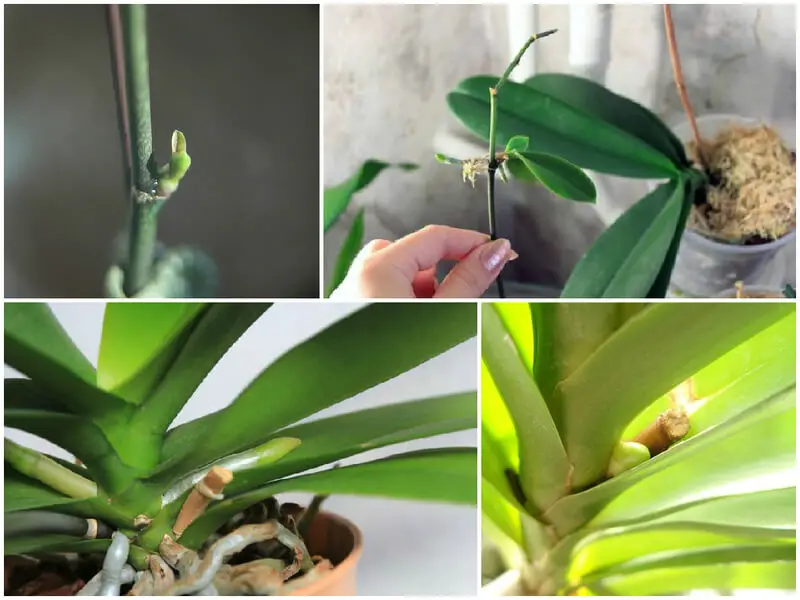
If, nevertheless, a baby appeared on an orchid peduncle what to do when your orchid has a baby? This is what will be discussed later in our article.
keiki orchid Care
In order for a baby to appear on a peduncle, certain growing conditions are required, namely:
- high humidity;
- a lot of diffused sunlight;
- the ambient temperature is not less than 25-27 degrees Celsius.
If these conditions are created for the flower, then soon after flowering, children can be expected.
IMPORTANT! If the humidity is low, then instead of children, a lateral peduncle will grow.
baby orchid Appearance
Impatient flower growers, at the first signs of growth of a waiting bud, want to know how to determine whether a peduncle or a baby has emerged from it. Experienced flower growers will help here, they are of the opinion that on the 5th day the growing peduncle has a sharp tip of growth, and the baby is rounded.
But it will be quite clear what happened from the waiting kidney, for 10-15 days.
If you want to know about How To Revive Orchid Phalaenopsis?
what orchid Keiki or baby orchid look like?
Below you can see several photos of the baby on the peduncle. First, a rosette of young leaves develops, and then roots will appear.
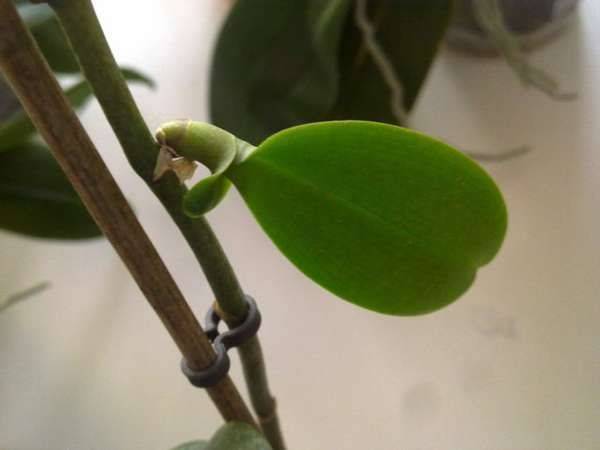
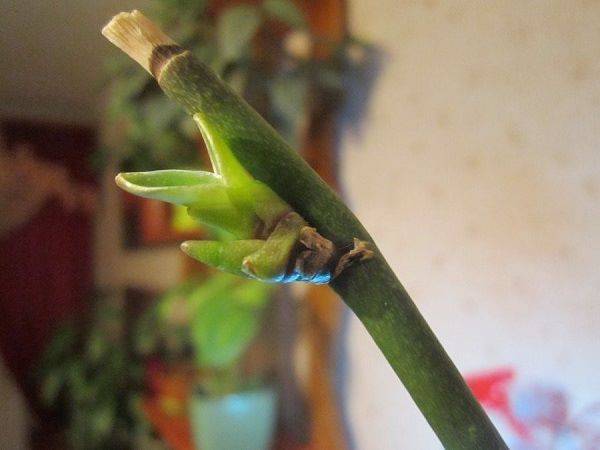
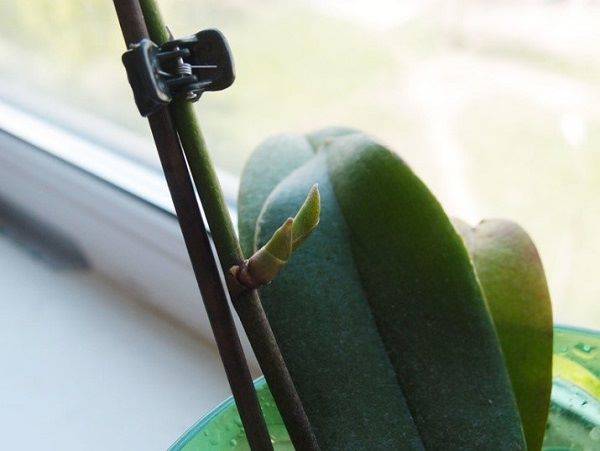
Orchid Baby Mother plant care
Many growers believe that it is impossible to propagate an orchid with the help of a child. This confidence is created for them, because they do not have the right conditions for the appearance of a young sprout and they do not know how to get a baby from a peduncle.
First of all, you need to choose the right time. It comes in the spring after the flowering of the plant. The peduncle is shortened to the upper waiting bud, cutting it 2 cm higher. Pruning is done with pruning shears, after which the cut is dried and covered with garden var.
Basic conditions for the appearance of a baby:
- humidity – it is increased with the help of containers with water, or you can choose the wettest place in the apartment, where it is warm and humid, this is the kitchen. Food is often cooked there, due to which the humidity of the air rises and the temperature rises;
- lighting – if the room is located on the north side, then in the spring additional lighting will be needed for the education of the child;
- top dressing – it is necessary to apply fertilizer for orchid plants with a greater proportion of nitrogen components necessary for the development of the baby.
I would like to remind you that the mother plant itself, before the start of reproduction, must have an absolutely healthy appearance and must not have pests on itself. Then the orchid is pruned and placed in a humid, warm place with sufficient lighting.
Watering is done as needed with warm and soft water. And do not forget to add top dressing, because nitrogen is necessary for the formation of new cells and the growth of a young baby.
IMPORTANT! For the appearance of a baby, it is necessary to create the necessary conditions for keeping the mother plant.
If you love Yellow Orchid Flower.
using keiki paste on orchids
If a baby appeared on a mother plant on a faded peduncle, then they leave it and help the bush to grow a baby on itself. If all the conditions for the content are met and the plant is healthy, and the baby does not appear from the peduncle, you can use hormonal paste or Keiki paste.
To do this, remove the integumentary tissue from the waiting kidney and slightly injure it with a sterile needle. After that, the hormonal paste is applied to the kidney with a needle or a match. After the expiration of 10 days, the shoot will begin to develop.
IMPORTANT! To make the humidity higher, you can wrap the waiting kidney in cellophane, leaving an airflow.
what to do when your orchid has a baby?
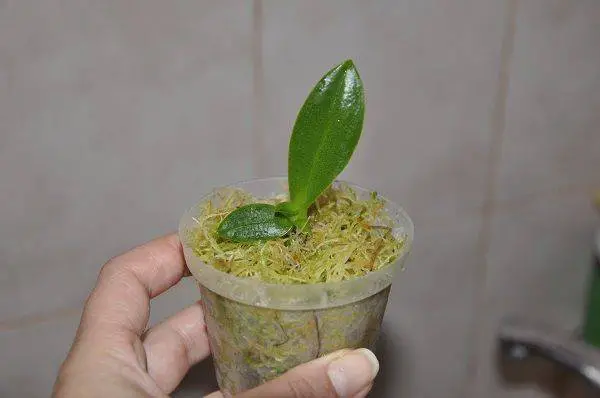
Orchid baby transplant Time
From the moment when the baby appeared on the peduncle and until the time when she is ready for transplantation, at least six months pass. Sometimes it will take her longer.
It depends on how much energy the mother plant has, at what time of year the baby appeared, and how many of them were formed on one bush. After all, we must remember that it is difficult for an average orchid bush to grow even 3 children on its peduncles.
When can you separate orchids baby?
A flower grower, having received a baby for the first time and having grown it to a certain size, wonders if she is ready for separation?
First of all, you need to pay attention to the fact that the roots are in the amount of 2-3 pieces and reach a length of 5 cm. At the same time, there should be 4 pieces on a young rosette young leaf.
If all this is available, then the baby is ready to be separated from the mother plant.
When you can not separate baby orchids?
If the baby has not reached a certain size or its root system is in its infancy, then it is impossible to separate it from the main bush, since it may not survive on its own. Only if it breaks off through negligence or the main bush dies, you can try to save it by growing it in a greenhouse, but this does not always give a positive result.
Therefore, it is advisable to leave the bush on the mother plant as long as possible in order to obtain the correct size necessary for the survival of the young orchid. Next, we will tell you how to separate the grown bush from the mother.
how to remove keiki from orchid?
The process of trimming the baby itself is quite simple, but it is worth paying attention to certain points. It is necessary to cut off so that the remains of the peduncle are no more than 2 cm on both sides.
It is impossible to unscrew a young outlet since it can be said with great confidence that it will be damaged when unscrewing it.
Baby after separation.
Tools to remove orchid baby
A garden pruner is considered the best tool for cutting babies, as its cut heals quickly on flower branches. But we must remember that after each cut, the secateurs must be treated with alcohol. This is done so that if one plant is infected, the entire collection is not infected.
In the absence of a sector, you can use:
- scalpel;
- scissors.
IMPORTANT! It is not recommended to cut with a knife, as there is a possibility of damage to the baby.
where do you replant a baby orchid?
The baby is planted in a container of a certain type and size. The pot should be the size of the root system and be transparent. The substrate is selected from small fractions of the bark and a little sphagnum moss is added.
If the roots are practically absent, and the baby is already separated, then she is planted in a mini-greenhouse. Wet sphagnum moss is placed on the bottom, and the baby is fixed above it in such a way that the roots are missing 2 cm to the moss.
They will grow, stretching towards moisture.
ways to remove orchid baby
With a sharp pruner, cut off the peduncle with the baby and leave it for 2-3 hours to dry the slices. After that, the sections are treated with one of the antiseptics:
- activated carbon;
- wood ash;
- cinnamon.
The process of how to plant a baby from a peduncle:
- In a selected plastic container (you can use a plastic cup, having previously made holes in it from the bottom), pour 2-3 cm of bark , which will serve as drainage;
- Then the baby is exposed so that its root system is at the level of the upper edge of the container . If 3 cm of bark is not enough, you need to fill it up;
- When adding bark, it is not rammed, but gaps are left with air pockets;
- You can put sphagnum moss as a top layer , but it should not touch the rosette and leaves.
Baby orchid after planting.
After planting, the baby is not watered for 3 days, allowing small cracks that could appear on the root system to heal.
care for removed orchid baby
After the young rosette is planted, the same care is carried out for it as for an adult plant. Only watering will be carried out more often since the small container dries out rather quickly.
check out Plastic vs Ceramic pots.
How do you root a baby orchid?
Sometimes, for some reason, the root mass is missing on the baby of the orchid plant. In this case, you need to help the orchid with its build-up.
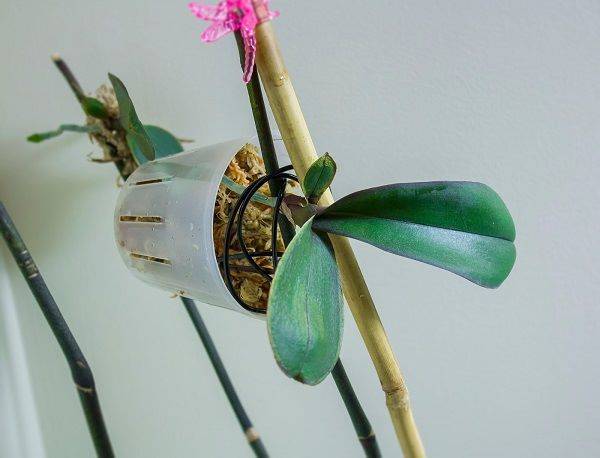
On mother plant
If the baby is missing roots, but it is still growing on the peduncle, you can help the plant grow them.
To do this, using an elastic band or thread, carefully fix the sphagnum moss on the peduncle 3-4 cm below the child without roots. And as it dries, we moisten the moss. This increases the amount of moisture, and the roots will be forced to appear and stretch towards the wet moss.
Extension of roots with sphagnum moss.
IMPORTANT! Moss will dry out differently depending on the temperature in the room. In the summer, it can dry out within 24 hours. But when moisturizing it, one must remember that you should not spray it on the baby, as rot may occur in its leaf sinuses.
root baby orchid after speration
The separated baby can be placed in a plastic or glass cup, at the bottom of which there will be moss. It should be constantly wet and this will help the baby to build up its root mass. If the room lacks moisture, then this glass is placed in a transparent plastic bag.
Potential problems During removal of Orchid baby
Problems can arise if an inexperienced florist begins to break it out, thereby breaking the outlet. If you carefully cut it off and process the sections, then there will be no problems with the young outlet during transplantation. It is also important to follow the rule of the first watering and carry it out for the first time on the 3rd day.
Conclusion
Child-assisted reproduction is the easiest way to propagate your own orchid. There is nothing complicated in the process itself, you just need to fulfill all the requirements for the separation and transplantation of a young plant.
